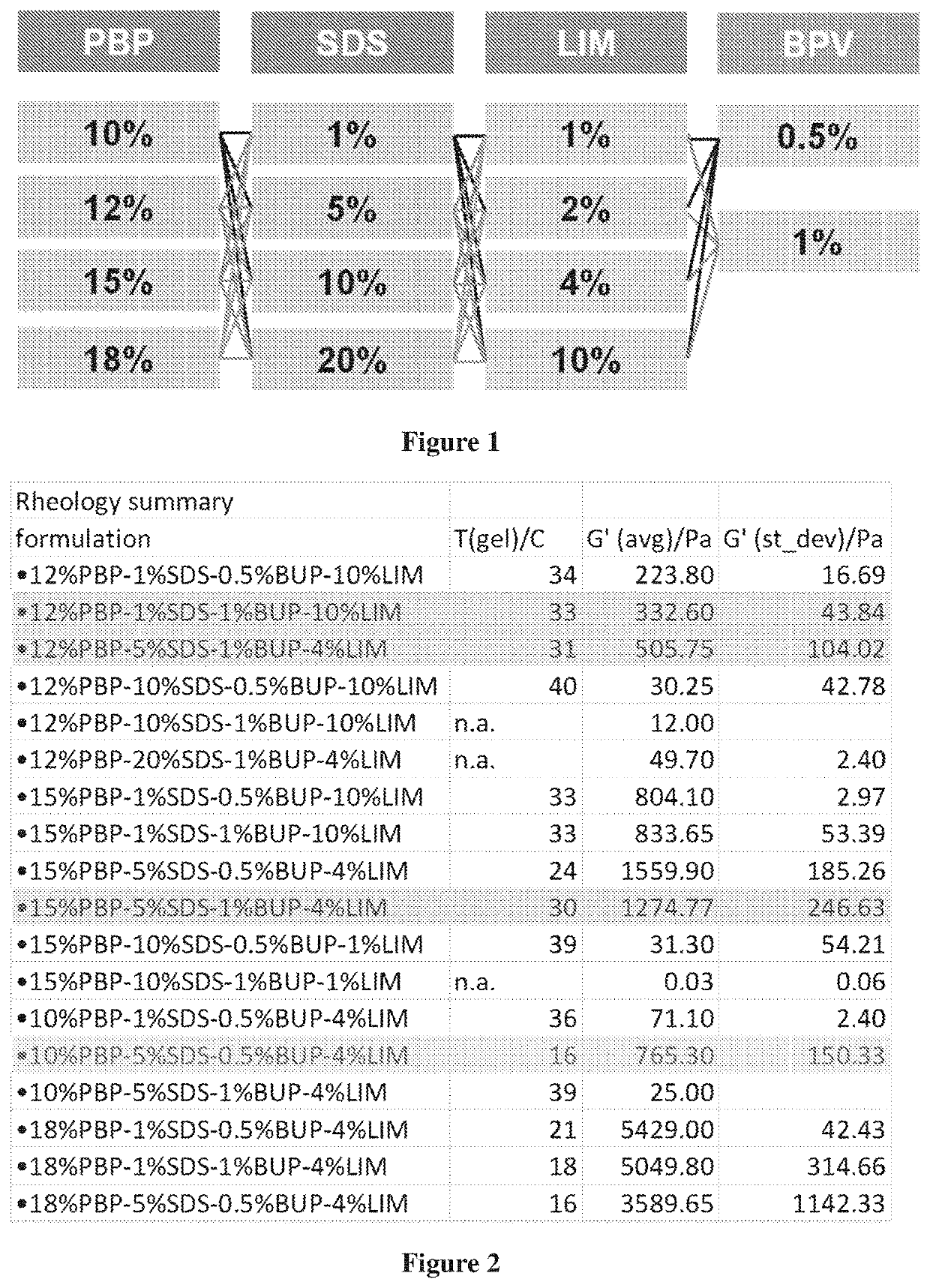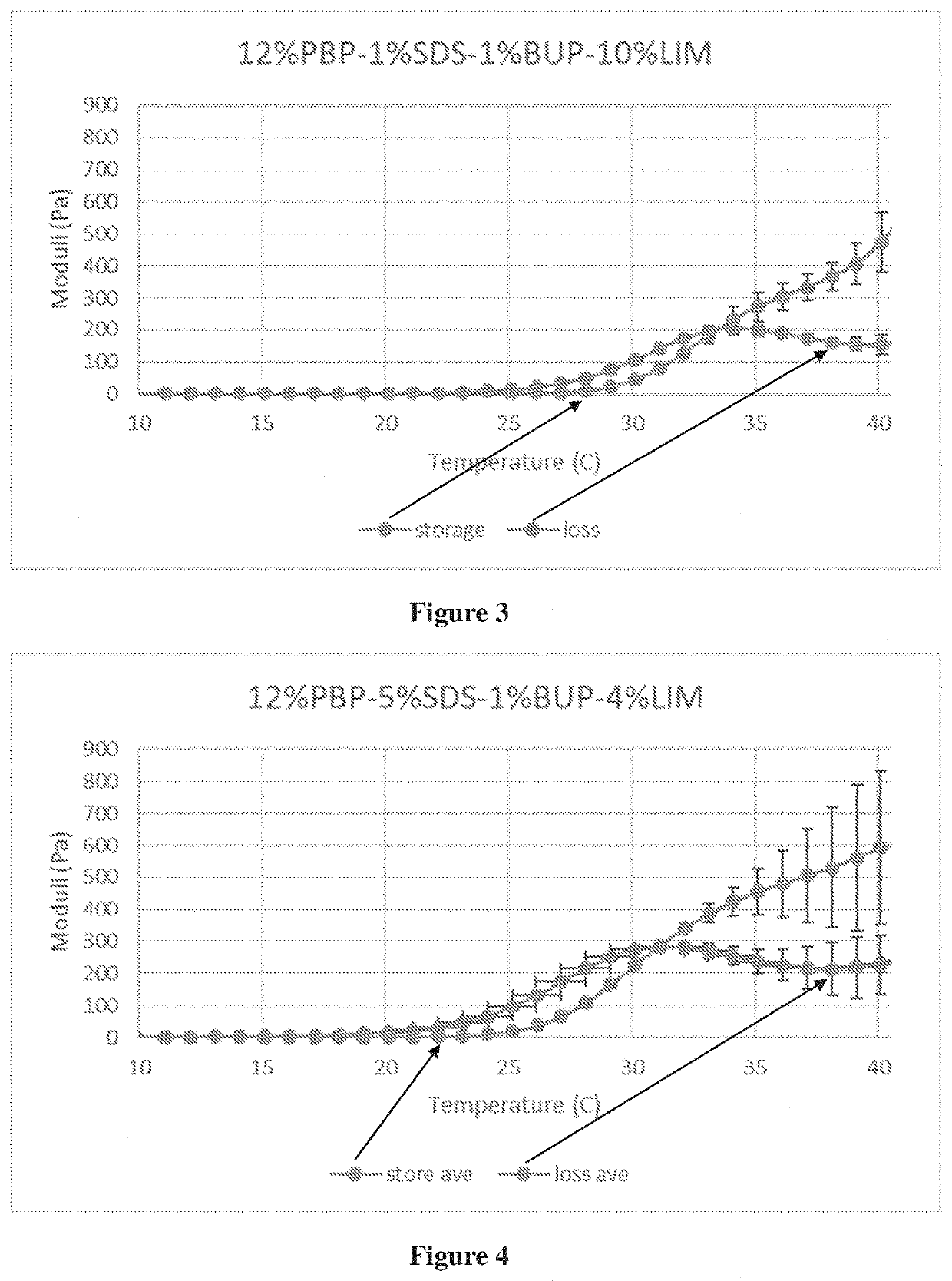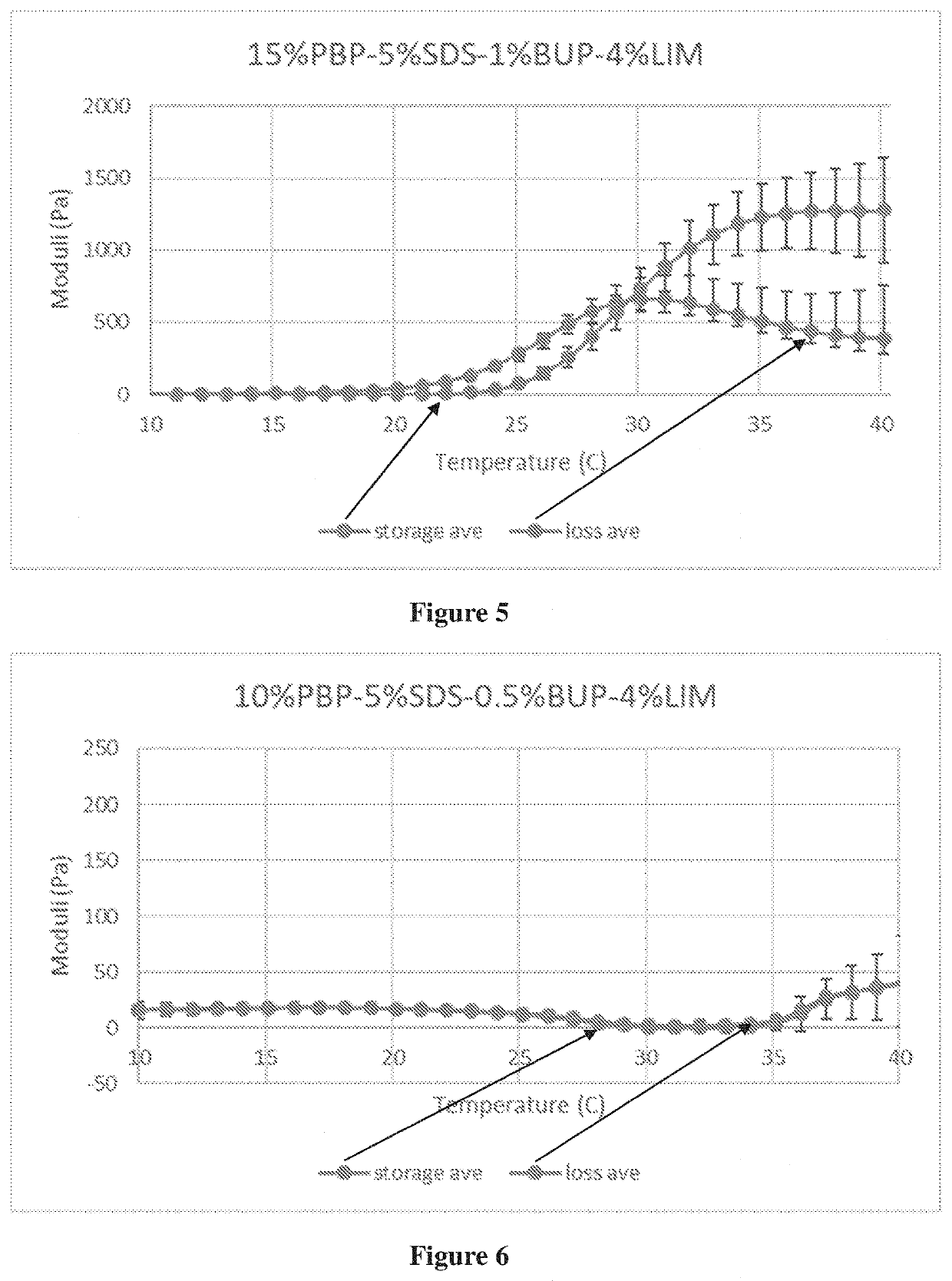Compositions with synergistic permeation enhancers for drug delivery
a technology of enhancers and compounds, applied in the field of compositions with synergistic permeation enhancers for drug delivery, can solve the problems of increased disability and death compared with infections, difficulty in compliance with multi-dose regimens, and increased resistance to antibiotics, so as to improve the flux of therapeutic agents, improve the effect of drug delivery, or not significantly impaired, and the local concentration is high
- Summary
- Abstract
- Description
- Claims
- Application Information
AI Technical Summary
Benefits of technology
Problems solved by technology
Method used
Image
Examples
example 1
[0244]The exemplary compositions were analyzed for favorable properties with regard to gelation and syringeability. The rheology data, including the storage modulus (G′) and the loss modulus (G″), were plotted over a temperature range of the composition. Trans-tympanic and biocompatibility experiments are also performed.
[0245]Exemplary viable compositions with reasonable gelation and syringeability properties include compositions of: 12% PBP-1% SDS-0.5% BUP-10% LIM, 12% PBP-1% SDS-1% BUP-10% LIM, 12% PBP-5% SDS-1% BUP-4% LIM, 12% PBP-10% SDS-0.5% BUP-10% LIM, 12% PBP-10% SDS-1% BUP-10% LIM, 12% PBP-20% SDS-1% BUP-4% LIM, 15% PBP-1% SDS-0.5% BUP-10% LIM, 15% PBP-1% SDS-1% BUP-10% LIM, 15% PBP-5% SDS-0.5% BUP-4% LIM, 15% PBP-5% SDS-1% BUP-4% LIM, 15% PBP-10% SDS-0.5% BUP-1% LIM, 15% PBP-10% SDS-1% BUP-1% LIM, 10% PBP-1% SDS-0.5% BUP-4% LIM, 10% PBP-5% SDS-0.5% BUP-4% LIM, 10% PBP-5% SDS-1% BUP-4% LIM, 18% PBP-1% SDS-0.5% BUP-4% LIM, 18% PBP-1% SDS-1% BUP-4% LIM, and 18% PBP-5% SDS-0.5...
example 2
ons and Properties with Reference to Gelation, Syringeability, Storage Modulus, and Gelation Temperature
[0246]
TABLE 1Data summary for composition formulation optimization, group 1.GelationGelationTest:Test:StorageLiquidTurnsmodulusGelationSolutionunder roomSolid at bodySyringeabilityat 37° C.TempGroup-1Testedtemp.?temp.?Test:X(Pa)(° C.)Sub-sub-sub-12%, 1%,YesMost1group 1-1group 1-1-10.5%, 1%12%, 1%,YesMost10.5%, 2%12%, 1%,YesSome10.5%, 4%12%, 1%,YesMost1223.8 ± 16.7 340.5%, 10%sub-sub-12%, 1%,YesYes1group 1-1-21%, 1%12%, 1%,YesYes11%, 2%12%, 1%,YesSome11%, 4%12%, 1%,YesSome1332.6 ± 43.8 331%, 10%Sub-sub-sub-12%, 5%,YesYes4group 1-2group 1-2-10.5%, 1%12%, 5%,YesYes20.5%, 2%12%, 5%,YesYes30.5%, 4%12%, 5%,YesYes40.5%, 10%sub-sub-12%, 5%,YesYes3group 1-2-21%, 1%12%, 5%,YesYes21%, 2%12%, 5%,YesYes2505.8 ± 104.2311%, 4%12%, 5%,YesYes31%, 10%Sub-sub-sub-12%, 10%,YesNo, for 10 s,2group 1-3group 1-3-10.5%, 1%20 s, 30 s, 40 s12%, 10%,NoSome30.5%, 2%12%, 10%,YesNo30.5%, 4%12%, 10%,YesSome330.3...
example 4
[0252]Here, the use of this trans-tympanic drug delivery system to deliver local anesthetics across the TM was also studied. Bupivacaine, an amphiphilic amino-amide local anesthetic in current clinical use, which has been found to have an intrinsic activity as a CPE, was studied. Tetrodotoxin (TTX), a very hydrophilic compound that blocks the same sodium channel as bupivacaine but at a different site, and has ultrapotent local anesthetic activity, was also studied. Bupivacaine and TTX are known to strongly increase each other's anesthetic effects when given in combination15-17.
Materials
[0253]2-chloro-2-oxo-1,3,2-dioxaphospholane (COP), 1,8-diazabicyclo[5.4.0]undec-7-ene (DBU), n-butanol, diethyl ether, acetic acid, anhydrous dichloromethane, anhydrous tetrahydrofuran, SDS, LIM, and US pharmaceutical grade BUP and bupivacaine free base (BUP-fb) were used as received from Sigma-Aldrich (St. Louis, Mo.). US pharmaceutical grade TTX was used as received from Abcam Inc. (Boston, Mass.). ...
PUM
| Property | Measurement | Unit |
|---|---|---|
| phase transition temperature | aaaaa | aaaaa |
| size | aaaaa | aaaaa |
| storage modulus | aaaaa | aaaaa |
Abstract
Description
Claims
Application Information
 Login to View More
Login to View More - R&D
- Intellectual Property
- Life Sciences
- Materials
- Tech Scout
- Unparalleled Data Quality
- Higher Quality Content
- 60% Fewer Hallucinations
Browse by: Latest US Patents, China's latest patents, Technical Efficacy Thesaurus, Application Domain, Technology Topic, Popular Technical Reports.
© 2025 PatSnap. All rights reserved.Legal|Privacy policy|Modern Slavery Act Transparency Statement|Sitemap|About US| Contact US: help@patsnap.com



